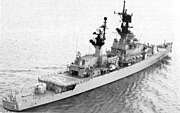Flush deck

Flush deck is a term in naval architecture. It can refer to any deck of a ship which is continuous from stem to stern.[citation needed] It has two specific common referents:
- Flush deck aircraft carriers are those with no island superstructure, so that the top deck of the vessel consists of only an unbroken flight deck.
- "Flush deckers" is a common nickname for a series of American destroyers built in large quantities during or shortly after World War I – the Template:Sclass-, Template:Sclass-, and Template:Sclass- classes – so called because they lacked the raised forecastle of preceding American destroyers, thus the main deck was a flush deck.[1]
Two different meanings of "flush"
This section possibly contains original research. (October 2014) |
"Flush deck" with "flush" in its generic meaning of "even or level; forming an unbroken plane", is sometimes applied to vessels, as in describing yachts lacking a raised pilothouse for instance. "Flush deck aircraft carrier" uses "flush deck" in this generic sense.
"Flush deck" in its more specific maritime-architecture sense denotes (for instance) the flush deck destroyers described above: the flush decks are broken by masts, guns, funnels, and other structures and impediments, and are far from being unbroken planes. "Flush deck" in this sense only signifies that the main deck runs the length of the ship and does not end before the stem (with a separate raised forecastle deck forward) or before the stern (with a separate raised or, as seen on many modern warships, lowered quarterdeck rearward).
-
USS Allen is not a flush-deck vessel: note the raised forecastle deck forward, running about one-quarter the length of the ship
-
In contrast, the flush-deck USS Sigourney (later HMS Newport) has no forecastle
-
USS Belknap, a later example of a non-flush-deck ship, with the main deck giving way to a lower quarterdeck towards the stern
History
The flushed deck design was introduced with rice ships built in Bengal Subah, Mughal India (modern Bangladesh), resulting in hulls that were stronger and less prone to leak than the structurally weak hulls of traditional European ships built with a stepped deck design. This was a key innovation in shipbuilding at the time. The British East India Company later duplicated the flushed deck design of Bengal rice ships in the 1760s, leading to significant improvements in seaworthiness and navigation for European ships during the Industrial Revolution.[2]
References
- ^ "Flush Deckers". Destroyer History Foundation. Retrieved October 20, 2014.
- ^ "Technological Dynamism in a Stagnant Sector: Safety at Sea during the Early Industrial Revolution" (PDF).
{{cite web}}: Cite has empty unknown parameter:|dead-url=(help)


